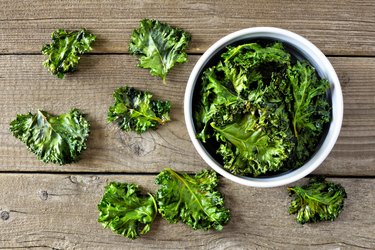
Whether you choose Swiss chard vs. collard greens vs. kale, they are three varieties of cooking greens that won't add a high number to your daily calorie counter. They are also a good source of vitamins and minerals.
Curly leaved kale is often added to potato recipes. Collard greens, or collards, are popular in Southern cuisine. Both are members of the cabbage family. Swiss chard has thick, dark leaves and a flavor similar to spinach.
Video of the Day
Video of the Day
Read more: 10 Sneaky Ways to Eat More Vegetables
Enjoy the Benefits of Kale
Kale is low in calories — there are only 42 calories in a 1-cup serving. One cup of cooked and drained kale also contains:
- 3.5 grams of protein
- 1.4 grams of fat
- 6.3 grams of carbohydrates
- 4.7 grams of fiber
- 1.4 grams of sugars
Kale is also an excellent source of certain vitamins, providing 295 percent of the daily value of vitamin A for women and 229 percent of the daily value for men, according to the National Academies of Sciences. Kale also contains additional minerals, including 18 percent of your daily calcium.
Collard Greens Nutrition
One cup of cooked, boiled and drained collard greens has only 63 calories and 1 gram of sugars, according to the USDA. Like kale, collard greens contain only 1 gram of fat and 30 micrograms of sodium. With 11 grams of carbohydrates and 5 grams of protein, collard greens contain slightly more of these nutrients than either kale or Swiss chard. Of the three types of greens, collards offer the highest amount of fiber, with 8 grams per cup.
This vegetable's vitamin content is similar to other greens, with a high amount of vitamin A. With 26 percent of the daily value of calcium, of the three types of greens, collards provide you with the most of this important mineral.
Add Some Swiss Chard
Cooked, boiled and drained Swiss chard contains a mere 35 calories per cup, according to the USDA — the least of these three greens. It is also the lowest in fat, having 0 grams. Similar to kale and collard greens, Swiss chard also includes:
- 7 grams of carbohydrates
- 4 grams of fiber
- 2 grams of sugar
- 3 grams of protein
Swiss chard stands out from the other two in its sodium content, however. Even when prepared with no added salt, Swiss chard contains 313 micrograms of sodium, so you will want to avoid adding any extra salt to a dish containing this vegetable. Like kale and collard greens, Swiss chard is an excellent source of vitamin A.
At 50 percent of the daily value for men and 22 percent of the daily value for women, Swiss chard is the best source of iron among these three types of greens.
Read more: Do Vegetables Lose Nutrients When Cooked?
Include Them All
Whether you add kale, collard greens or Swiss chard to your plate, you are making a smart choice. Each is low in fat and cholesterol, but an excellent source of fiber. Besides calcium, iron and vitamins A and C, these greens also supply vitamins E, K and B6, thiamin, folate, riboflavin, magnesium, manganese and potassium.
- USDA National Nutrient Database: "Collard, Cooked, Boiled, Drained, Without Salt"
- USDA National Nutrient Database: "Chard, Swiss, Cooked, Boiled, Drained, Without Salt"
- USDA National Nutrient Database: "Kale Cooked Boiled, Drained Without Salt"
- National Academies of Sciences: "Vitamins and Minerals"